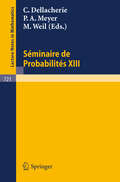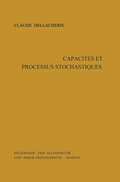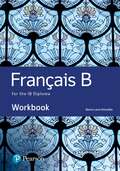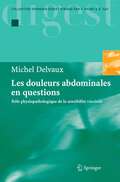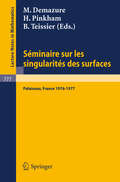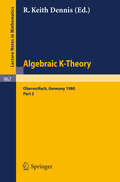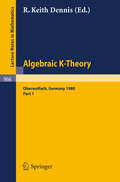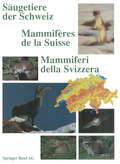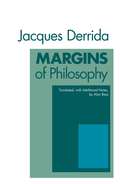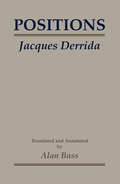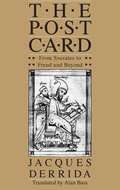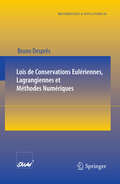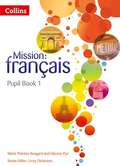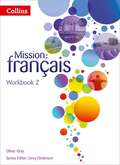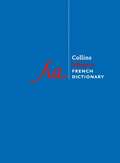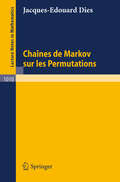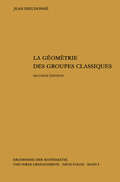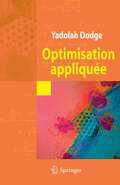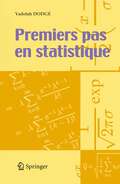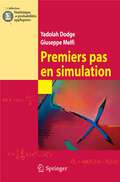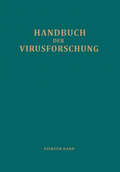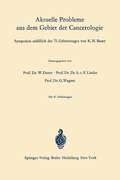- Table View
- List View
Séminaire de Probabilités XIII: Université de Strasbourg 1977/78 (Lecture Notes in Mathematics #721)
by C. Dellacherie P. A. Meyer M. WeilCapacités et processus stochastiques (Ergebnisse der Mathematik und ihrer Grenzgebiete. 2. Folge #67)
by Claude DellacherieThis book consists of two sections. The first section (A) is dealing with sets, capacities and measures of sets, giving elementary but deep theorems about approximation of measures and capacities for instance by compact sets. Besides concepts such as "paving capacity" and "capacibility" several modern and quite new concepts such as "capacitance", "mosaic", "envelope", and "scarper" ("rabotage") are introduces in order to describe refinements of the structure of classes of sets. Using these concepts the author proves in a new way know theorems such as Choquet's theorem in abstract form and he also gives new theorems for instance theorems about analytic sets. The second section (B) presents a general theory of stochastic processes but is mainly concerned with fundaments. It gives a far-reaching theory of stopping times and q-fields belonging to stopping times and classifications of stopping times and q-fields. This theory is then applied to stochastic processes, particularly to processes with realizations that are increasing functions. This book is well-fitted for researchers, who need a thorough knowledge of stochastic processes. H. Bergström.
Modèles aléatoires: Applications aux sciences de l'ingénieur et du vivant (Mathématiques et Applications #57)
by Jean-François Delmas Benjamin JourdainCet ouvrage présente des modèles aléatoires élémentaires et certaines de leurs applications courantes : algorithmes d'optimisation, gestion des approvisionnements, dimensionnement de files d'attente, fiabilité et dimensionnement d'ouvrages. Des problématiques plus récentes sont également abordées : recherche de séquences exceptionnelles et de zones homogènes de l'ADN, estimation du taux de mutation de l'ADN, phénomènes de coagulation de molécules de polymères ou d'aérosols.
French B for the IB Diploma Workbook (Pearson International Baccalaureate Diploma: International Editions)
by Marie-Laure DelvalleeOur unique and flexible write-in Workbook provides focused practice to prepare students for their end of course assessments. Exercises to prepare students for the reading, writing, speaking and listening assessments, with QR codes linking to audio samples. Students are encouraged to make the workbook their own, writing in answers, highlighting and making notes – perfect for revision. The structure of the workbooks by prescribed theme means they can be used alongside, rather than instead of, other resources. Topical authentic texts and visual stimuli, accompanied by a broad range of questions and exercises, with links to intercultural themes and TOK throughout. Clearly differentiated content for both Standard and Higher Level students.
Les douleurs abdominales en questions: Rôle physiopathologique de la sensibilité viscérale (Collection Springer Digest)
by Michel DelvauxL'axe cerveau-intestin désigne l’ensemble des voies nerveuses qui relient le plexus myentérique, véritable cerveau intestinal, et le système nerveux central. Près de 80 % de ces neurones sont des neurones sensitifs et les voies afférentes qui transmettent les informations du tractus digestif vers le système nerveux central jouent un rôle important dans la régulation physiologique des fonctions digestives ainsi que dans certains états pathologiques. Une large majorité de ces sensations restent inconscientes et donnent naissance à des réponses réflexes. Seules celles qui demandent une réponse contrôlée par la volonté atteignent le niveau de conscience à l’état normal (faim, soif, besoin de déféquer). En situation pathologique, il en va de même pour les sensations douloureuses d’origine digestive. Les troubles fonctionnels intestinaux sont un motif fréquent de consultation. Leur physiopathologie est aujourd’hui fondée sur un modèle intégrant les différents facteurs étiologiques autour de l’axe cerveau-intestin. Ces patients présentent fréquemment une hypersensibilité viscérale qui se traduit par une perception accrue des sensations digestives et notamment l’apparition d’une douleur en réponse à des stimuli non douloureux chez des sujets normaux. La reconnaissance du rôle de l’hypersensibilité viscérale a permis d’expliquer le mode d’action de médicaments utilisés pour le traitement des troubles fonctionnels intestinaux et ouvre la voie au développement de nouvelles molécules agissant au niveau des afférences digestives. Dans cet ouvrage, nous décrirons les bases anatomiques et physiologiques qui permettent de comprendre le concept de sensibilité viscérale et le rôle des afférences digestives dans la physiopathologie des douleurs abdominales aiguës et chroniques, en particulier le syndrome de l’intestin irritable.
Seminaire sur les Singularites des Surfaces: Centre de Mathematiques de l'Ecole Polytechnique, Palaiseau 1976-1977 (Lecture Notes in Mathematics #777)
by M. Demazure H. Pinkham B. TeissierAlgebraic K — Theory: Proceedings of a Conference Held at Oberwolfach, June 1980 Part II (Lecture Notes in Mathematics #967)
by R. Keith DennisAlgebraic K-Theory. Proceedings of a Conference Held at Oberwolfach, June 1980: Part 1 (Lecture Notes in Mathematics #966)
by R. Keith DennisSäugetiere der Schweiz / Mammifères de la Suisse / Mammiferi della Svizzera: Verbreitung · Biologie · Ökologie / Répartition · Biologie · Ecologie / Distribuzione · Biologia · Ecologia (Denkschriften der schweizerischen Naturforschenden Gesellschaft #103)
by Denkschriftenkommission Denkschriftenkommission DerMargins of Philosophy
by Jacques Derrida"In this densely imbricated volume Derrida pursues his devoted, relentless dismantling of the philosophical tradition, the tradition of Plato, Kant, Hegel, Nietzsche, Husserl, Heidegger—each dealt with in one or more of the essays. There are essays too on linguistics (Saussure, Benveniste, Austin) and on the nature of metaphor ("White Mythology"), the latter with important implications for literary theory. Derrida is fully in control of a dazzling stylistic register in this book—a source of true illumination for those prepared to follow his arduous path. Bass is a superb translator and annotator. His notes on the multilingual allusions and puns are a great service."—Alexander Gelley, Library Journal
Positions: Revised Edition (Athlone Contemporary European Thinkers Ser.)
by Jacques DerridaPositions is a collection of three interviews with Jacques Derrida that illuminate and make more accessible the complex concepts and terms treated extensively in such works as Writing and Difference and Dissemination. Derrida takes positions on his detractors, his supporters, and the two major preoccupations of French intellectual life, Marxism and psychoanalysis. The interviews included in this volume offer a multifaceted view of Derrida. "Implications: Interview with Henri Ronse" contains a succinct statement of principles. "Seminology and Grammatology: Interview with Julia Kristeva" provides important clarifications of the role played by linguistics in Derrida's work. "Positions: Interview with Jean-Louis Houdebine and Guy Scarpetta" is a wide-ranging discussion that touches on many of the polemics that Derrida's work has provoked. Alan Bass, whose translation of Writing and Difference was highly praised for its clarity, accuracy, and readability, has provided extremely useful critical notes, full of vital information, including historical background.
The Post Card: From Socrates to Freud and Beyond
by Jacques Derrida17 November 1979 You were reading a somewhat retro loveletter, the last in history. But you have not yet received it. Yes, its lack or excess of address prepares it to fall into all hands: a post card, an open letter in which the secret appears, but indecipherably. What does a post card want to say to you? On what conditions is it possible? Its destination traverses you, you no longer know who you are. At the very instant when from its address it interpellates, you, uniquely you, instead of reaching you it divides you or sets you aside, occasionally overlooks you. And you love and you do not love, it makes of you what you wish, it takes you, it leaves you, it gives you. On the other side of the card, look, a proposition is made to you, S and p, Socrates and plato. For once the former seems to write, and with his other hand he is even scratching. But what is Plato doing with his outstretched finger in his back? While you occupy yourself with turning it around in every direction, it is the picture that turns you around like a letter, in advance it deciphers you, it preoccupies space, it procures your words and gestures, all the bodies that you believe you invent in order to determine its outline. You find yourself, you, yourself, on its path. The thick support of the card, a book heavy and light, is also the specter of this scene, the analysis between Socrates and Plato, on the program of several others. Like the soothsayer, a "fortune-telling book" watches over and speculates on that-which-must-happen, on what it indeed might mean to happen, to arrive, to have to happen or arrive, to let or to make happen or arrive, to destine, to address, to send, to legate, to inherit, etc., if it all still signifies, between here and there, the near and the far, da und fort, the one or the other. You situate the subject of the book: between the posts and the analytic movement, the pleasure principle and the history of telecommunications, the post card and the purloined letter, in a word the transference from Socrates to Freud, and beyond. This satire of epistolary literature had to be farci, stuffed with addresses, postal codes, crypted missives, anonymous letters, all of it confided to so many modes, genres, and tones. In it I also abuse dates, signatures, titles or references, language itself. J. D. "With The Post Card, as with Glas, Derrida appears more as writer than as philosopher. Or we could say that here, in what is in part a mock epistolary novel (the long section is called "Envois," roughly, "dispatches" ), he stages his writing more overtly than in the scholarly works. . . . The Post Card also contains a series of self-reflective essays, largely focused on Freud, in which Derrida is beautifully lucid and direct."—Alexander Gelley, Library Journal
The Post Card: From Socrates to Freud and Beyond
by Jacques Derrida17 November 1979 You were reading a somewhat retro loveletter, the last in history. But you have not yet received it. Yes, its lack or excess of address prepares it to fall into all hands: a post card, an open letter in which the secret appears, but indecipherably. What does a post card want to say to you? On what conditions is it possible? Its destination traverses you, you no longer know who you are. At the very instant when from its address it interpellates, you, uniquely you, instead of reaching you it divides you or sets you aside, occasionally overlooks you. And you love and you do not love, it makes of you what you wish, it takes you, it leaves you, it gives you. On the other side of the card, look, a proposition is made to you, S and p, Socrates and plato. For once the former seems to write, and with his other hand he is even scratching. But what is Plato doing with his outstretched finger in his back? While you occupy yourself with turning it around in every direction, it is the picture that turns you around like a letter, in advance it deciphers you, it preoccupies space, it procures your words and gestures, all the bodies that you believe you invent in order to determine its outline. You find yourself, you, yourself, on its path. The thick support of the card, a book heavy and light, is also the specter of this scene, the analysis between Socrates and Plato, on the program of several others. Like the soothsayer, a "fortune-telling book" watches over and speculates on that-which-must-happen, on what it indeed might mean to happen, to arrive, to have to happen or arrive, to let or to make happen or arrive, to destine, to address, to send, to legate, to inherit, etc., if it all still signifies, between here and there, the near and the far, da und fort, the one or the other. You situate the subject of the book: between the posts and the analytic movement, the pleasure principle and the history of telecommunications, the post card and the purloined letter, in a word the transference from Socrates to Freud, and beyond. This satire of epistolary literature had to be farci, stuffed with addresses, postal codes, crypted missives, anonymous letters, all of it confided to so many modes, genres, and tones. In it I also abuse dates, signatures, titles or references, language itself. J. D. "With The Post Card, as with Glas, Derrida appears more as writer than as philosopher. Or we could say that here, in what is in part a mock epistolary novel (the long section is called "Envois," roughly, "dispatches" ), he stages his writing more overtly than in the scholarly works. . . . The Post Card also contains a series of self-reflective essays, largely focused on Freud, in which Derrida is beautifully lucid and direct."—Alexander Gelley, Library Journal
Lois de Conservations Eulériennes, Lagrangiennes et Méthodes Numériques (Mathématiques et Applications #68)
by Bruno DesprésLes systèmes de lois de conservation non linéaires modélisent les écoulements compressibles et incompressibles dans des domaines extrêmement variés tels que l'aéronautique, l'hydrodynamique, la physique des plasmas, la combustion, le trafic routier, l'élasticité non linéaire. Le cadre mathématique général est celui des systèmes de lois de conservation. Les exemples physiques sont nombreux et souvent spectaculaires. Cela contribue à fonder une nouvelle discipline, la Mécanique des Fluides Numérique. La présentation proposée porte l'accent sur les systèmes que l'on appellera lagrangiens ou écrits en coordonnées de Lagrange, sur leurs relations avec les systèmes en coordonnées d'Euler et sur les possibilités que cela offre pour la construction et l'analyse de schémas numériques entropiques. De nombreux exemples numériques sont présentés en liaison avec le contexte physique, ainsi que des exercices. It has long been observed that systems of conservation laws written in the Lagrange variable offer a good alternative for the numerical computation of approximate solutions. In this monograph we seek to develop a systematic presentation of the use of the Lagrange variable for the analysis and discretization of systems of conservation laws arising in continuum mechanics.
Fortschritte der Chemie Organischer Naturstoffe / Progress in the Chemistry of Organic Natural Products / Progrès dans la Chimie des Substances Organiques Naturelles (Fortschritte der Chemie organischer Naturstoffe Progress in the Chemistry of Organic Natural Products #19)
by D.H.R. Barton J. E. Courtois L. Crombie M. Elliot S. Ito A. Lino G. A. Morrison T. Nozoe H. H. Schlubach F. Sorm E.E. Van TamelenMission: français - Pupil Book 1 (PDF)
by Linzy Dickinson Marie-Thérèse Bougard Glennis PyeDiscover how learning French can be fun and rewarding with Mission: francais Pupil Book 1. * Provide clear differentiation for all from one book per year with more difficult tasks marked with a star * Bring contexts to life with video openers for each module which include French speaking worldwide contexts * Access a faster route for those who are finding the activities easy or doing a 2-year course with the Voie Express feature box * Start each topic with grammar to give all students the building blocks to express themselves and progress * Navigate through the 4 skills (speaking, listening, writing and reading) with ease through the clear labelling and layout of the page * Access abundant extension materials for all abilities, including extended reading texts based on authentic material * Equip pupils with an understanding of the mechanics of language through How Language Works pages * Provide motivation to progress and link modules through an ongoing comic book story * Prepare for the revised French GCSE with a focus on grammar and translation to and from French
Mission: français — Workbook 2 (PDF)
by Linzy Dickinson Oliver GrayReinforce the grammar and language points covered in Pupil Book 2 with plenty of practice for everyone. Ensure the top end is stretched with the more challenging tasks included. * Focus solely on grammar and language, crucial aspects of the new secondary curriculum * Easy to use and personalise with the write-in format * Slot easily into teaching plans with content that exactly matches Pupil Book topics * Set for homework, with grammar summary boxes to support independent study * Boost engagement with the attractive full-colour design * Assess progress with the Mission accomplie? feature
Collins Robert French Dictionary (PDF)
by Collins DictionariesThe world's leading French-English dictionary, a joint collaboration between Collins and Le Robert, now revised and updated to cover all the latest vocabulary in both languages. The perfect dictionary for advanced learners of French. With over 310,000 words, meanings and phrases and 500,000 translations. This tenth edition of the market-leading Collins Robert French dictionary uses Collins' and Le Robert's unique multi-million word databases of contemporary English and French to ensure that the user has the most complete and accurate picture of real language available today. The dictionary is ideal for advanced learners and professionals using French. This edition has been revised to include all the latest vocabulary from a wide range of fields, including new additions from the fields of the Internet, the environment and economics. Culture boxes explain the origins of phrases from literature, film and popular culture to aid translation and improve your understanding of French popular culture. Long and complex entries benefit from a clear structure and layout, with key phrases, idioms and set grammatical structures highlighted. Acclaimed Language in Use supplement contains hundreds of examples of usage in real-life contexts such as essay writing, email and telephone conversations to help you use French fluently and naturally. Includes detailed colour maps of the English and French-speaking worlds.
La geometrie des groupes classiques: Reihe: Gruppentheorie (Ergebnisse der Mathematik und ihrer Grenzgebiete. 2. Folge #5)
by Jean DieudonneThis book gives an excellent survey of recent work on classical groups, simplifying and unifying the results of many authors. No attempt is made to cover all of the voluminous literature on classical groups; the author deals with only that portion of the subject which can be handled by the methods of linear algebra. By thus restricting his scope, he is able to include proofs of most of the results described, thereby making the book more self-contained than most Ergebnisse tracts.In the reviewer's opinion, this is an important and well-written book which should help to stimulate research on the classical groups. The book not only gives a thorough exposition of the present state of the subject, but is also an excellent introduction to the modern techniques basic to further work in this field.
Optimisation appliquée: Série Statistique Et Probabilités Appliquées
by Yadolah DodgeCet ouvrage présente les concepts fondamentaux d'optimisation classique et de programmation linéaire. Outre un prologue et un épilogue, l'ouvrage comporte une partie de théorie mathématique sur le calcul matriciel et les systèmes d'équations et d'inéquations linéaires. Il traite ensuite d'optimisation classique avec et sans contraintes, de programmation linéaire, de la méthode du simplexe et du simplexe révisé. Les derniers chapitres sont consacrés à la dualité, à la post-optimisation et analyse de sensibilité ainsi qu'aux problèmes de transport. L'accent a été mis sur l'explication des méthodes exposées et leur utilisation. De nombreux exemples numériques tirés de diverses situations de la vie économique et sociale sont proposés. Chaque chapitre se termine par une série d'exercices illustrant les différents concepts et méthodes étudiés. Les solutions de tous les exercices sont présentées à la fin de l'ouvrage. Certains sujets de programmation linéaire, comme par exemple la théorie des graphes ou celle des réseaux n'ont pas été abordés dans cet ouvrage. Les personnes intéressées pourront enrichir leur connaissance en consultant les ouvrages cités en référence. Cet ouvrage est destiné aux étudiants d'économie, de gestion, d'informatique de gestion et de mathématiques appliquées. Il s'adresse également aux chercheurs de divers domaines des sciences appliquées ainsi qu'aux professeurs qui disposent ainsi d'un support pour leur enseignement.
Premiers pas en statistique
by Yadolah DodgeCet ouvrage présente les concepts fondamentaux de la théorie statistique et décrit les méthodes les plus souvent utilisées dans la pratique. Il est destiné aux étudiants en sciences économiques et sociales dont le programme d'études inclut une connaissance étendue des méthodes statistiques. Il s'adresse aussi aux chercheurs de divers domaines des sciences appliquées ainsi qu'aux étudiants qui envisagent de poursuivre ultérieurement une étude plus approfondie de la théorie statistique et de ses applications. L'ouvrage comporte trois parties: statistique déscriptive, probabilités et statistique inférentielle.
Premiers pas en simulation (Statistique et probabilités appliquées)
by Yadolah Dodge Giuseppe Melfi1.1 Pourquoi des techniques de simulation? Les méthodes de simulation, conçues pour être utilisées en statistique et en recherche opérationnelle, ont connu et connaissent encore un développement rapide dû à l’extraordinaire évolution des ordinateurs. Des applications se r- contrenttantdans l’industriequ’enéconomie,ouencoreensciencessociales,en physique des particules, en astronomie et dans de nombreux autres domaines. Dans beaucoup de situations, que ce soit de la vie courante ou dans la - cherchescienti?que,lechercheurestconfrontéàdesproblèmesdontilrecherche des solutions sur la base de certaines hypothèses et contraintes de départ. Pour résoudre ce type de problème, il existe des méthodes analytiques applicables à des situations où le modèle permet de traiter les di?érentes variables par des équations mathématiquement maniables, et des méthodes numériques où la complexité du modèle impose un morcellement du problème, notamment par l’identi?cation des di?érentes variables qui entrent en jeu et l’étude de leurs interactions. Cette dernière approche s’accompagne souvent d’une importante massedecalculs.Lestechniquesdesimulationsontdestechniques numériques: simuler un phénomène signi?e essentiellement reconstituer de façon ?ctive son évolution. Après un bref aperçu historique sur l’évolution du concept de hasard et de sonusageàtraverslessiècles,leParagraphe1.3présentelaproblématiquedela simulationest présentéedans toutesa généralitésous ses di?érents aspects.Les paragraphes suivants montrent des exemples où des techniques de simulation peuvent être appliquées.
